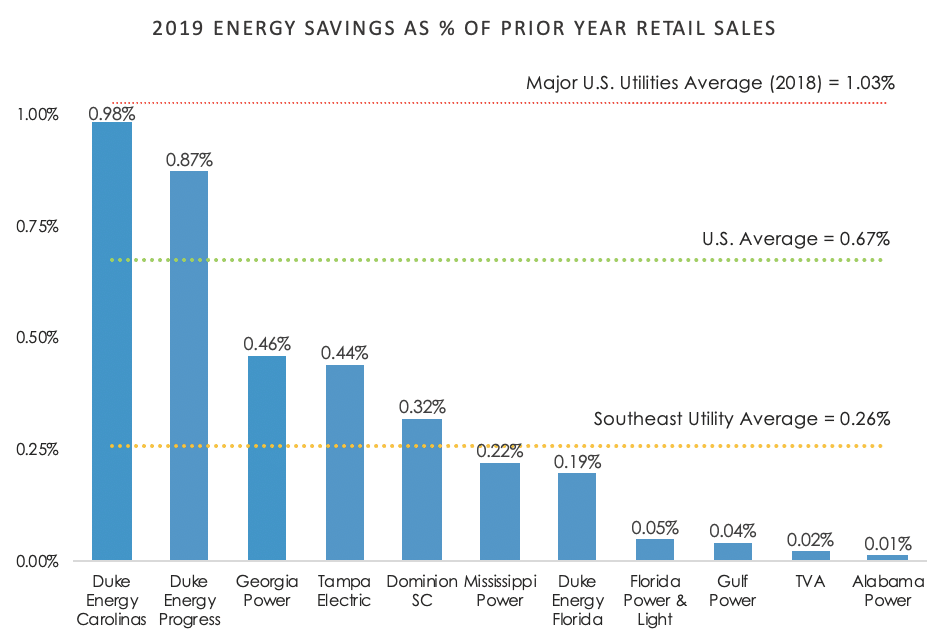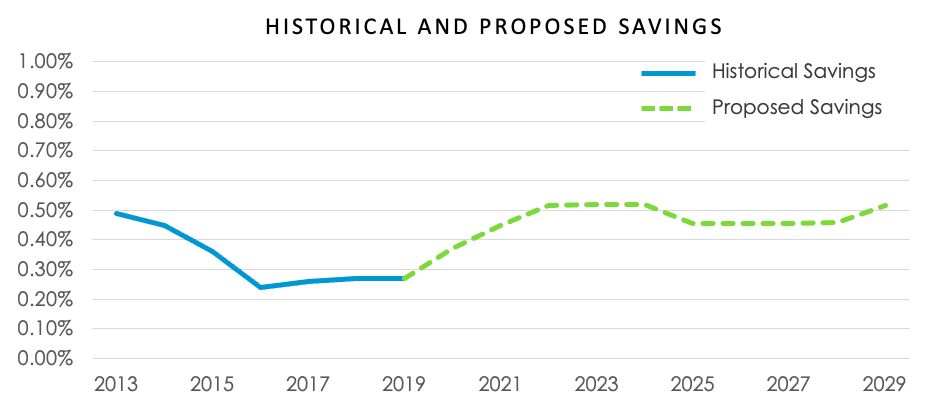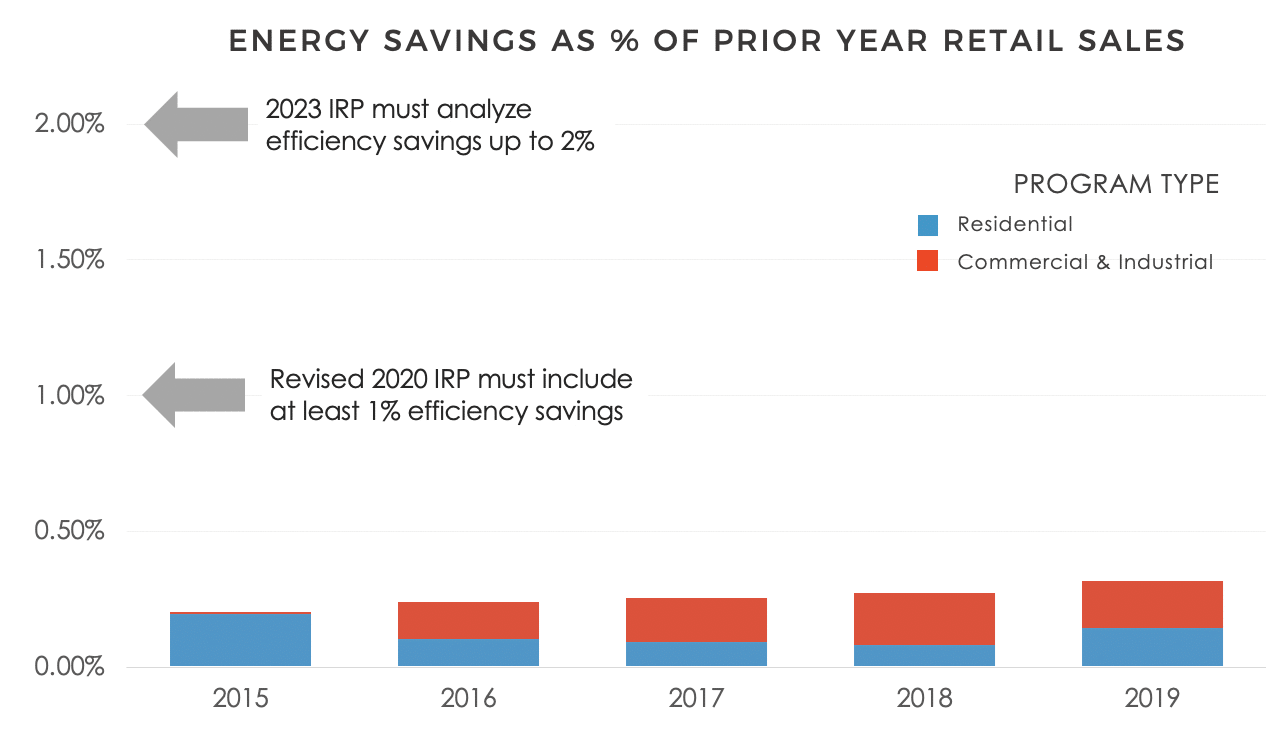After years of decline, Dominion Energy has turned a corner and is slowly increasing its annual efficiency savings - but the Public Service Commission is pushing the utility to move much faster on efficiency in its integrated resource planning.
Forest Bradley-Wright | February 25, 2021 | Energy Efficiency, Energy Policy, South Carolina, UtilitiesThis is the fourth in a series of blogs tied to SACE’s third annual “Energy Efficiency in the Southeast” report. Each year SACE compiles efficiency performance data from nearly 500 electric utilities in the Southeast. The first three blogs in this series introduced this year’s efficiency report; highlighted Duke Energy’s performance as a regional leader; and identified ways Duke can still strive for higher savings on par with national leaders. Our focus now turns to the new regulatory landscape in South Carolina that is putting pressure on Dominion Energy to pursue more energy efficiency through its integrated resource plan. In the coming weeks, additional blogs will highlight individual states, utilities, and key trends affecting energy efficiency in the region.
Download the Report
Read the Report Series
Watch the report webinar
After years of decline, Dominion Energy has turned a corner and begun slowly increasing its annual efficiency savings. But Dominion’s Integrated Resource Plan (IRP) was recently rejected by the South Carolina Public Service Commission (PSC) for failing to meet new requirements in the 2019 Energy Freedom Act. In response, Dominion submitted a modified IRP last week that phases out all coal generation increases renewable energy, and includes higher levels of energy efficiency. Yet questions still remain concerning Dominion’s approach to pursuing further efficiency savings.

Dominion’s Efficiency Performance
In 2019, Dominion was middle of the pack among Southeastern utilities, with 0.32% annual efficiency as a percentage of electric sales. Though slightly above the regional average, it trailed neighboring utilities Georgia Power, Duke Energy Progress, and Duke Energy Carolinas by a considerable degree, and it delivered less than half the national efficiency savings average. But the national average actually makes Dominion look better than it would against comparable utilities because it includes a multitude of smaller electric companies, co-ops, and municipal utilities that do little or no efficiency. In an analysis of the nation’s 52 largest electric utilities, the American Council for an Energy Efficient Economy (ACEEE) determined that the average annual efficiency savings for major utilities in 2018 was 1.03%. In this analysis, Dominion ranked 43rd out of 52.
Head-to-Head, Dominion and Duke Energy
Duke Energy Carolinas, Duke Energy Progress, and Dominion all operate in South Carolina under the same PSC and similar energy efficiency policies. Back in 2013, Dominion and the Duke Energy system (which also includes Duke Energy Florida) had essentially the same annual efficiency performance. But since then, Duke increased its average annual savings by about 60%, while Dominion’s performance has fallen by roughly 50%.

Several factors drove the divergence between these utilities. While Dominion’s Stakeholder Advisory Group typically meets two to three times a year, the Duke Collaborative meets every other month to develop and modify its efficiency programs, and has at least as many working group meetings in between. Dominion seeks regulatory approval for its efficiency program portfolio only once every 5 years, while Duke is typically proposing multiple new or modified programs each year.
But the biggest factor separating these utilities was an ill-conceived attempt by South Carolina Electric & Gas (now Dominion) to build the V.C. Summer nuclear power plant, which redirected funds away from energy efficiency before collapsing as an undisputed financial disaster. Only after the project went bust did the utility seek to ramp efficiency savings back up, and then only to about where they had been prior to their downward slide since 2013.

A New Regulatory Landscape
Since the collapse of the V.C. Summer nuclear plant, the regulatory landscape for energy in South Carolina has shifted considerably. In 2019, the state legislature enacted the Energy Freedom Act, which requires consideration of higher levels of energy efficiency in integrated resource planning and clearly states that utilities must seek the “most reasonable and prudent” mix of energy resources to meet future customer needs. In the past, many utilities ignored or minimized the role of energy efficiency. Subsequently, the new requirements are significant. Meanwhile, all seven SC Public Service Commissioners that were involved in decisions related to the V.C. Summer nuclear plant fiasco have now been replaced, ushering in a new era for utility regulation.
Dominion was the first South Carolina utility to submit a full IRP after the Energy Freedom Act took effect, but it initially took a dismissive approach to modeling higher efficiency levels. Advocates pushed back and the response from the Commission was unambiguous – it rejected Dominion’s IRP in late 2020 and required the company to perform a “rapid assessment” and include annual efficiency savings of at least 1%. For its 2023 IRP cycle, Dominion must go even further, analyzing annual efficiency savings all the way up to 2%.

Dominion Submits Its Modified IRP
Last Friday, February 18th, Dominion submitted its modified IRP for Commission review and approval, along with a required rapid assessment of higher energy efficiency savings levels. Despite previously claiming that 1% annual savings could not be achieved cost-effectively, Dominion now acknowledges that it can. Oddly, however, the utility stated that it ran out of time and did not actually use the finding from its rapid assessment as the basis for the 1% savings levels in the new plan. This, in turn, raises a number of serious questions:
- What assumptions did Dominion use for its efficiency cost inputs and load profiles?
- How much money will customers save at the higher 1% level (in net present value) compared to what the company had previously proposed?
- Did the utility attempt to boost its annual savings percentage by excluding opted-out commercial and industrial customers? In other words, is Dominion even showing 1% efficiency savings based on its actual retail sales?
Reaching for Higher Efficiency Savings
Going forward, we know that achieving high levels of efficiency savings will require a broad mix of programs and careful attention to program design. Done well, this means offering efficiency programs to all types of customers, while pursuing both deep and persistent savings. Unfortunately, Dominion’s rapid assessment derives nearly all of its additional savings only from Home Energy Reports, which produce savings that generally only count for one year.
Experiences across the country show that higher savings are indeed possible. The PSC’s recent Order also required Dominion to analyze efficiency savings at much higher levels than 1% for its 2023 IRP, continuing all the way up to 2% annual savings. Clearly, Dominion will have to look for new approaches to reach this level, and a good place to start is by draw insights from utilities who are already doing more. Fortunately, of the 52 largest utilities in the ACEEE study mentioned above, 25 had annual efficiency savings above 1%. In the second part of our recent Duke energy efficiency blog post, we examined several strategies that could also apply to Dominion.
Achieving high levels of efficiency savings is neither easy nor automatic. It takes real effort. To get there, Dominion Energy South Carolina will need to really step up, including through its energy efficiency Stakeholder Advisory Group. SACE remains committed to working with Dominion as it pursues the higher levels of efficiency savings required by the PSC, while also striving to ensure the benefits of energy efficiency reach customers who struggle with excessive energy burdens. At the end of the day, this will require all hands on deck, and one simply cannot overstate the importance of continued engagement, oversight, and leadership by the South Carolina Commission – which has already demonstrated its considerable impact on Dominion’s IRP.
Find out more from our “Energy Efficiency in the Southeast” third annual report, blog series, and further resources below:
Download the Report
Read the Report Series
Watch the report webinar
#SEEnergyEfficiencyReport2021